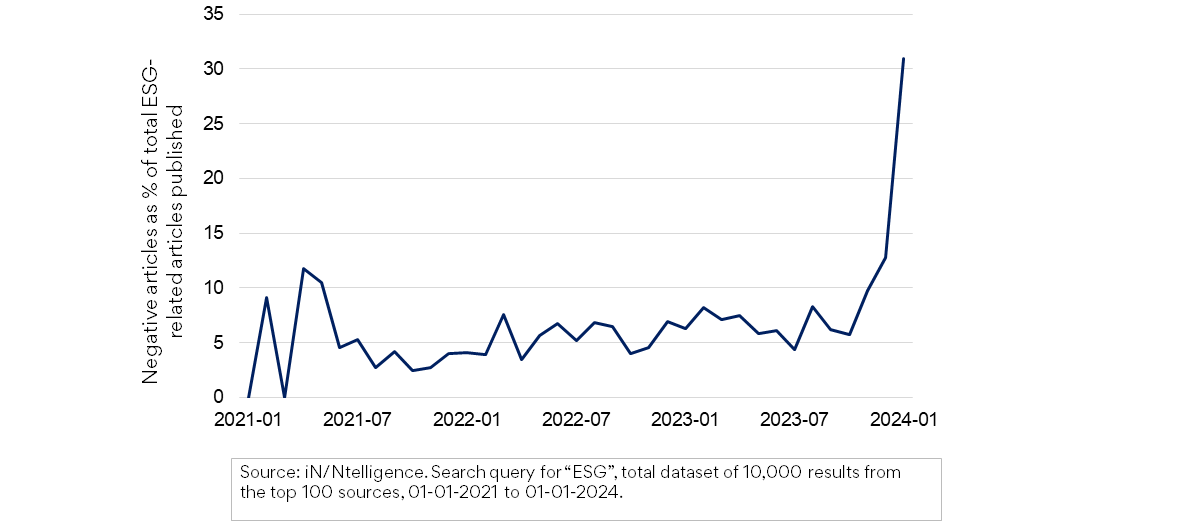In a world riven by culture wars, even the most well-meaning causes can find themselves besieged by criticism. The recent backlash against environmental, social, and governance (ESG) initiatives serves as a case in point. Once hailed as the way forward, ESG has become a political battleground, drawing fire from all sides.
According to our proprietary iN/Ntelligence platform – which identifies trends by trawling thousands of news sources – the number of negative news articles on ESG (as a percentage of total ESG-related articles) have dramatically risen in recent months.
Negative-sounding ESG News Articles Have Gone Up Dramatically

Critics, ranging from investment industry insiders to politicians, have attacked ESG proponents for either doing too little or too much. This has pushed some in the investment industry to gravitate towards “greenhushing” – toning down the messaging, or completely keeping quiet, about their ESG efforts. Others have purged ESG from company rhetoric and replaced it with anodyne terms like “transition investing.”
Similarly, diversity, equity, and inclusion (DEI) – a component of ESG – has also become a beleaguered concept, with some organisations reconsidering whether they want to publicly highlight their DEI efforts or even pursue them at all.
Keeping the faith
So, where does this leave purpose- or mission-driven companies? Can organisations still come out publicly and identify with a "good" mission without the risk of it backfiring?
The good news is that there are still organisations out there that are undeterred: a recent global survey by consultancy firm Teneo revealed that 92% of CEOs say they plan to continue their ESG initiatives despite the politicisation of the topic.
Scepticism and criticism are an inevitable part of any change process. Their degrees are proportional to the level of misunderstanding of what that change, and its mission and purpose, is about. Tackling this challenge boils down to good storytelling.
At N/N, we help companies communicate and demonstrate their purpose with clarity and authenticity – two characteristics foundational to any successful messaging – to both internal and external stakeholders. Because, like the first two houses in the Three Little Pigs tale, flimsily built narratives can collapse with the slightest huff and puff.
The checklist
So how can companies ensure their messaging efforts survive scrutiny? Here are some simple questions for companies to ponder.
1. Are you there yet?
Be honest about your progress. If you haven't fully achieved your goals, don't claim otherwise. Some of the backlash against ESG in the investment industry has stemmed from poor transparency or outright dishonesty on what companies are doing (greenwashing). The larger the gap between reality and marketing, the bigger the distrust. Instead, acknowledge what still needs doing while demonstrating a commitment to improvement.
2. Can you go the distance?
Is your mission deeply embedded in your company culture, or is it merely a top-down directive? Developing credibility around a “good” cause requires consistent effort over time across the organisation and not a quick marketing blitz. Companies like Patagonia have built a strong voice around sustainability by consistently putting their money where their mouth is.
3. Is everyone on board?
Before your organisation embraces a mission, stress-test your corporate commitment. It's harder to walk back or away from a cause, which will only fuel more scepticism about your intentions, however genuine they may be. Ensure that the idea has been broadly socialised and gauge the sentiment of your employees towards the idea. This is where effective internal communications become indispensable. Communicate the rationale and benefits clearly, explaining the "why", such as the ways in which a particular initiative will support business objectives as well as benefit the broader community – and listen for feedback.
4. Are you acknowledging the downsides?
Recognising and addressing concerns and negative externalities is crucial to maintaining trust. Listening and engaging with those that hold opposing views may help avoid an antagonistic environment and to find common ground. Do not shy away from acknowledging the short-term trade-offs while touting the long-term benefits.
5. Can you be (mis)understood?
Do people understand what you’re trying to achieve? Communicate in language so that they do. For example, words like “net zero” or “carbon neutral” may come across as abstract terms for some audiences but impact is easier to understand – for example “cleaner water,” “cleaner air”, or “equal access to the same opportunities as others.”
Change is underway in some quarters, with J.P. Morgan Chairman and CEO Jamie Dimon clarifying the bank’s climate change terminology in his letter to shareholders this year, noting: “We are going to use the word “commitment” much more reservedly in the future, clearly differentiating between aspirations we are actively striving toward and binding commitments.”
To be sure, purpose-driven companies these days need to navigate a complex landscape, both in terms of a greater natural scepticism engendered by rising disinformation and polarised viewpoints, as well as a tough business environment that makes it challenging to stay focused on doing good while staying profitable.
By proactively engaging employees, communicating effectively, and demonstrating authentic commitment, companies can improve their chances of proving the naysayers wrong and successfully championing "good" missions.
World-class communications strategy and execution
Contact us to get started